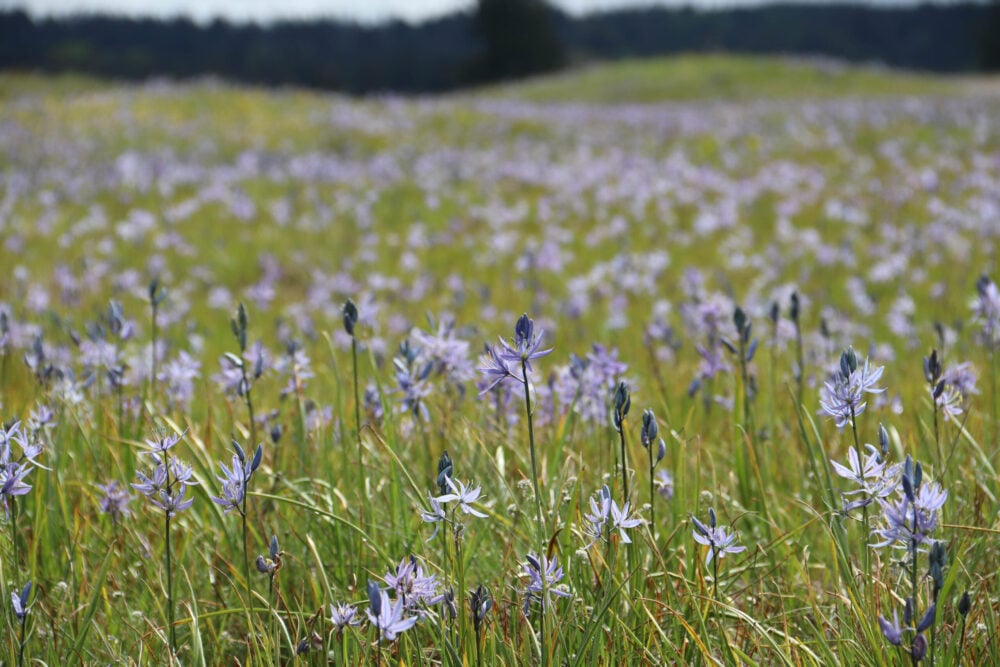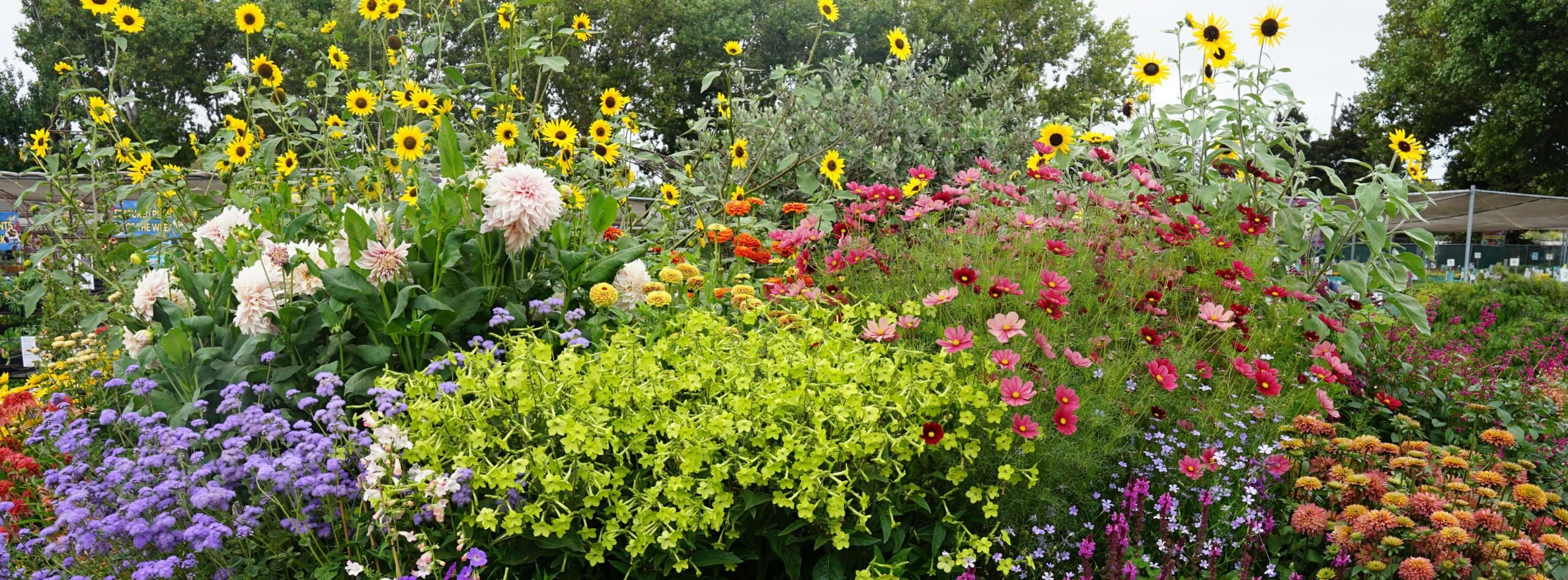
Habitat Hedges—the Friendliest Screening

Contributor
- Topics: Inspired Gardens and Design
Fall 2024
Erica settled in her weathered red chair, becoming part of the forested South Hills landscape. She watched black-capped chickadees (Poecile atricapillus) hop-stepping up and down the slender limbs of Pacific wax myrtle (Myrica californica). One bird swooped from the shelter of the hedge down to the fountain near Erica’s seat for a splash and a drink. Satiated, or spooked—it’s hard to know which—the chickadee took wing and returned to the sanctuary of the leafy hedge to rest.
Header Image: A lightly pruned, mix hedge including Myrica californica and Rosa nutkana, grows in front of a privacy fence providing a friendly edge and frame to the garden. Seattle Residence, Native Gardens by GGN; Image credit: Tess Schiavone

Since planting the mostly native backyard garden in Eugene, Oregon six years ago, Erica’s seen a diversity of birds using the perimeter hedge for shelter and sustenance. The red chair has become her evening place to unwind and expand her awareness of the beauty of nature.
She told me that the neighbors like the hedge, too, how it’s quickly grown above the height of the fence to give them privacy. “It’s not a ‘Keep Out’ kind of privacy, though. It’s friendly,” she said, gesturing to the way the wind dances through the willowy leaves.
I often advise home gardeners to start by designing and planting a mixed habitat hedge. It softens boundaries, connecting your yard to the surrounding landscape instead of separating it the way a fence or wall does. It’s essential for your sense of well-being within the built environment. It’s also the easiest way to provide for your wild neighbors—the birds, the bees, and other small creatures.
The role of hedges in garden design
Imagine stepping from the walled-in experience indoors, out your back door, to a view of multi-textured green, a foreground green that blends into the far view of hazier green. Your neighbor’s trees, the distant hills, appear as they are—connected to the land where you now stand.
If instead, your view is of more walls (or fences) out your back door, do you feel the same connection? Does the landscape expand from your point of reference, or contract?
Perhaps your view includes an eyesore like a utility pole or a dilapidated shed. Or, hey, there’s your neighbor, in full view, raking leaves in the nude!

A good hedge serves to shelter privacy and screen the undesirable, while simultaneously connecting the scene to the larger landscape beyond your inner garden.
The perimeter of your backyard is a great place for a habitat hedge. You probably have a fence there already. Why not green it up, blur the built edge, add liveliness?
If you have a larger property, hedges can also stretch across your yard to create separate garden rooms. Define a social zone in your backyard and a contemplative zone, separated by an animated wall of green.
A hidden nook, embraced by above-head-height greenery, becomes a sanctuary, a retreat, a solace of reconnection to heal the stresses of the day.
In your front yard, a hedge could provide a thorny deterrent to ill-intentioned trespassers. There’s one maturing now at the end of my urban block that alternates tall Oregon grape (Berberis aquifolium, syn. Mahonia aquifolium), rugosa rose (Rosa rugosa), and purple Japanese barberry (Berberis thunbergii atropurpurea). The previous vandalizing appears to have been effectively thwarted.
When following property lines, well-chosen plants add lasting value. Planting a hedge is an act of generosity to future residents, including the winged, furred, and many-legged inhabitants.
In design terms, consider a hedge to be any mass of intermingled woody plants, planted in a row, that creates a visual wall of greenery. A hedge can contain three plants or three hundred. Scale is less relevant than density.
Choose a mix of species for resilience and diversity
A hedge planted with habitat in mind offers the same boundary-marking benefits of a traditional hedge, but with the bonus of attracting more diversity of birds and pollinators to your garden. You’ll get the most beauty and habitat with the least amount of work when you include locally adapted native plants, and when you mix it up with more than one species in a row.
In the Pacific Northwest, a few species are overplanted as hedges. English laurel (Prunus laurocerasus) requires constant pruning to rein in its will to mature to 30 feet tall (9.1 meters) and equally as wide. Its prolific, self-seeding offspring add to its high maintenance requirements. Another overused hedge plant, arborvitae (Thuja occidentalis) is plagued by fungal diseases that make it a short-lived option. It stands with brown gaps in the green like rotten teeth where individual plants have died.
You can do better.
The Pacific wax myrtle (Myrica californica, syn. Morella californica) in Erica’s garden has a lot going for it: it’s evergreen, native throughout the Pacific region, fast-growing, and nitrogen-fixing. It matures at a friendly height of about 15 feet (4.6 meters), takes beautifully to any amount of shearing if you want to reduce its size or tighten it up, and its fruits are enjoyed by many kinds of birds.
Sounds like a winner, doesn’t it? Usually, yes. But, know that Pacific wax myrtle can be susceptible to a leaf-blight disease (Phytophora taxon morella). It’s not perfect! Placing it in sun and pruning only in spring can help prevent infection.
Planting a mix of species can help even more. A hedge that depends on only one species is more vulnerable to loss from disease or extreme weather than one with multiple kinds of plants. Additionally, the diversity of a mixed hedge offers more seasonal interest and habitat value than a monoculture.
Build a well-composed community of plants in your hedge by first understanding your site’s soil and exposure, then gather a list of native plants that are naturally adapted to those conditions. I know this advice is not new. It’s worth repeating, though, when Pinterest and Instagram so seductively lure you to plant what’s fashionable over what’s locally appropriate.
Choose evergreens where year-round screening is important. Tall Oregon grape and many species of California lilac (Ceanothus) are worthy evergreen options for sunny aspects throughout the Pacific region. Toyon (Heteromeles arbutifolia) sets a bird buffet in gardens located in US Department of Agriculture Climate Zones 9–11. Western hemlock (Tsuga heterophylla) could be a choice for a shaded Pacific Northwest site, but only if you’re dedicated to shearing it well when it’s young.


Expand beyond evergreens, and even beyond shrubs, by including deciduous species and trees in the mix. A vine maple (Acer circinatum) and a blue elderberry (Sambucus caerulea) flank Erica’s Pacific wax myrtle hedge. They offer contrasting texture, flowers and berries for bees and birds, and greater height to block the two-story house next door. In winter, when the branches are bare, many deciduous plants continue to provide effective, lacy screening.
In a wet spot that vexes you, go for an all-deciduous mixed hedge of wetland species like Scouler’s willow (Salix scouleriana), Douglas spiraea (Spiraea douglasii), and red osier dogwood (Cornus sericea). Your “problem” is solved with beauty and habitat.

Adding a mixed hedge really is a great place to start integrating more native plants into your garden. Sometimes appropriate non-native species fit the site well, adding an element that might be missing in a 100 percent native community.
A mixed hedge I designed early in 2013 for a hot, streetside location consists of strawberry bush (Arbutus unedo ‘Compacta’), silverberry (Eleagnus x ebbingei), and smokebush (Cotinus ‘Grace’) in a repeating pattern. Though I’d be more inclined to work a native species or two in there now, it remains one of my favorites.

Offering fall blooms, like the fragrant silverberry and bumblebee-loved strawberry bush, when most natives have finished flowering, or spectacular fall color, like the rainbow display of Grace smokebush—classic garden shrubs can have a place in your habitat garden.

Consider planting “two-thirds for the birds,” or 70 percent native species, to provide adequate forage for your winged friends. Then have fun including that lilac (Syringa vulgaris) that reminds you of Grandma, or a Coppertina ninebark (Physocarpos opulifolius ‘Coppertina’) for your natural dyeing projects, or a reliably deer-resistant option like warty barberry (Berberis verruculosa) if browsing pressure is high.
Patterning
Once you have a list of plants you love that’s just right for your site, imagine a pattern, a rhythm, like music growing from the ground that’s composed of your chosen species. Remember, the goal is an intermingled woody mass, a wall of green. How will this wall read across the space?
It can be satisfying to overlap three different species multiple times along the row, like in the example above. Another version, with 70 percent natives plus an edible, could alternate tall Oregon grape (Berberis aquifolium), blue blossom (Ceanothus thyrsiflorus), and pineapple guava (Feijoa sellowiana). One after the other in a repeating pattern, this kind of hedge gives a legibility that’s understood, while also being unexpected.
Another approach could be to mass three or more of one species together in sequence, then stud it with an accent, maybe something taller like western chokecherry (Prunus virginiana var. demissa) to screen a looming eyesore. This is a good way to integrate trees into the hedge. They can become part of the continuous mass and stretch the height taller at just the right spot.
A formal style might call for a very limited number of species. Plant a single species hedge with companions staggered forward from the row for diversity and increased depth to your screening. An evergreen background of sheared Pacific wax myrtle with snowberries (Symphoricarpos albus) planted north of it, in its shade, gives the wax myrtle “socks” if its ankles become bare with defoliated lower limbs. Add a specimen like ‘Geisha Gone Wild’ Japanese maple (Acer palmatum ‘Geisha Gone Wild’) in front and your hedge becomes a complete vignette.
On the other end of the spectrum, a patternless assemblage of every plant on your list of possibilities, one after the other, unsheared, soft and wild, could be a thing of beauty, too. With more diversity in the row, one failed species is easier to absorb. Neighboring shrubs could expand to fill in the gap. Alternatively, a species that’s particularly thriving could be added to replace the loss.
Whatever your garden style, there’s an artistic way to integrate a mixed palette into your hedge.


Spacing
A common mistake when setting out plants for a hedge happens when you look at that cute little nursery-grown plant in its pot and cannot picture it growing into the full-sized mass it’s destined to become. So, you place it right up against your fence or walkway and crowd its companions just a couple feet apart along the row.
The screening effect may be immediately satisfying with very close planting, but long-term resilience is compromised. A few years after planting, you’ll be faced with powdery mildew, dead branches, and even whole shrubs failing for lack of light or healthy air flow.
Instead, understand the mature width of your chosen hedge species and plant about a foot closer on center for a balanced, overlapped mingling. For example, tall Oregon grape is known to grow to a width of about five feet (1.5 meters). So, plant them four feet (1.2 meters) apart from their neighbors in the row. In time, they’ll interweave but not overcrowd each other. That’s your goal!
If your new hedge is in front of a fence, allow for some space for air to flow around the plants. Consider planting 30 inches (76 centimeters) away from the fenceline at minimum, farther out for larger plants.
Yes, your young hedge will be visibly perforated between the individuals. Have patience. Healthy plants grow quickly!


Establishment
Speaking of growth, what you do (and don’t do) during the establishment phase of the first three years or so will guide your new hedge towards its best self.
Whether you’ve chosen drought-adapted species or not, deep watering will be essential to train young roots to grow down. Picture strong roots following the water into the depths, where they’ll anchor the plants and tap into subsoil moisture as they mature.
The common mistake is to water too briefly and too frequently. This causes roots to grow shallowly to absorb that surface irrigation. They then become dependent on it. Instead, set your irrigation timer for a longer duration and at less-frequent intervals. Every soil texture varies. Investigate with test holes to learn how long you need to irrigate to penetrate thoroughly.
You likely already know the importance of a good mulch of organic material layered atop the ground surrounding your new plants. To conserve moisture, suppress weeds, and feed the soil microorganisms, this step can’t be forgotten.
You might also consider adding a ground-covering plant to the base of your hedge, a “green mulch” that will mature to take the place of imported mulch material. Wild strawberries (Fragraria spp.), Pacific waterleaf (Hydrohyllum tenuipes), or wood sorrel (Oxalis oregana) could do the trick.

Alternatively, a sunny side of a hedge could be the ideal spot to intentionally leave bare for ground-nesting bees. The back side could be the right spot for a hidden brush pile to provide habitat for other insects and small creatures.
Your hedge has the potential to create many layers of habitat when you’re as thoughtful about the ground plane as you are of the vertical choices.
Pruning
Regarding the vertical, how and when you prune might be the most significant interaction you have with the ongoing growth of your hedge.
With a child-like sense of wonder, imagine encountering an opening in a tightly sheared hedge—the invitation to pass through is obvious, it’s a doorway into the next room. You run, skip, hop on your way.
Now imagine the same encounter but this time the hedge is softly billowing and the opening less immediately apparent. Leaves reach out and caress your arm—the way through is a portal that may or may not lead anywhere known at all. Here you move slowly, noticing the bushtit nest hanging long within the tangle of limbs, the dapple of light across your eyes, the mingled scent of duff and bloom.
Both classically trimmed and naturalistically loose hedges have a place in the habitat garden. You get to choose the effect you want to create.
When the planting bordering the hedge is deep and layered, rambunctious with seasonal waves of flowers, a tightly clipped hedge offers a contrast in form that feels humanizing or intentional. Visitors understand the context through this orderly frame, and more readily inhabit the scene as a place for people as much as for wildlife.
A small garden where a patio or deck occupies a large percentage of the space already has all the structure it needs. In this case, a hedge that is pruned only lightly—not sheared, but artistically thinned to reveal the character of the branching—can be the balancing aesthetic that brings the scene to life.
In contact and conviviality
Erica, in her weathered red chair, with the wind new on her skin and winged presences delighting her eyes, is made whole in relationship to her garden. Immersed in the ever-changing landscape of native plants, birds, and insects, she rediscovers herself over and over again. As David Abram wrote in his classic The Spell of the Sensuous (1996), “We are human only in contact, and conviviality, with what is not human.”
A good hedge is a nurturing embrace of this essential, renewing experience. It serves as the lively, permeable boundary that allows you to fully inhabit your own sanctuary. Plant a mixed habitat hedge and let it be the container of your expanded, ecological self.
This article was Sponsored by:
Resources
Two Thirds for the Birds, by Perfect Earth Project
Abram, David. 1996. The Spell of the Sensuous. New York: Vintage Books.
Plant Answer Line. n.d. “Pacific wax myrtle growing conditions and care.” University of Washington.











Responses